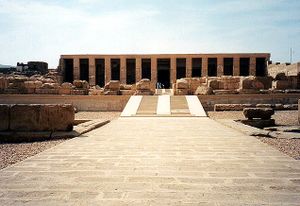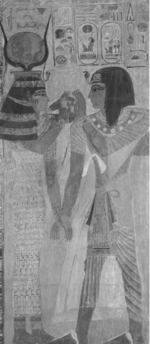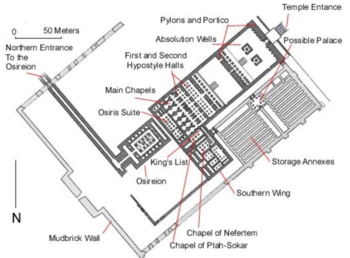Temple of Seti I Helicopter hieroglyphs
By: Christopher Reyes

The Temple of Seti I was constructed in memory of the 19th Dynasty and it was completed by his son, Ramesses II. Part of the plaster in the overhang has crumbled, revealing some interesting and unique hieroglyphics. They depicted strangely similar modern machines that caused eyebrows to raise wondering if Egyptians knew about modern technology. This would lead to psuedoarchaeologists to asks many questions to archaeologists about what the explanation is for this and if they have proof that extraterrestrials or another advanced civilization didn't come and join the Egyptians to build structures and help conquer battles using modern technology, like tanks, gliders, and helicopters.
Pharaoh Seti I

Seti I was the son of Ramses I and Queen Sitre. He followed the footsteps of his father, which was to become a military man. While in the military, he earned multiple titles, like troop commander, vizier and head archer, and this made him to be considered a powerful man throughout Egypt. He reigned from 1291 to 1279 BCE. Since his father only reigned Egypt for 2 years, people claimed that Seti was the real founder of the greatness of the Ramessids. During his reign, he led his army northward to restore Egyptian prestige. He battled in northern Palestine and Syria, but ended it with a peace treaty that may have established the frontier at Kadesh on the Orontes River. Seti truly made Egypt prosper during his reign. He fortified the frontier, dug wells, open mines, rebuilt temples and shrines that have been falling apart, and continued the work of his father in completing the great hypostyle hall at Karnak, which is deemed to be the most magnificent monument in Egyptian architecture. [2]
Temple of Seti I
The Temple of Seti I is located in Abydos, which is where many important and well-known pharaohs were buried. This temple is considered among the finest examples of ancient Egyptian art, also one of the largest memorial temples located along the edge of the floodplain to the south of Osiris’ Abydos temple. Seti I wanted his whole temple to be adorn with this type of Egyptian art, which was the largest in the Valley of the Kings at Thebes. This temple was not completed while Seti I was still alive. His son, Ramses II, who succeeded his father and became one of the greatest pharaohs of Ancient Egypt, completed Seti I's temple during his reign. [3]
Temple of Seti I's Art
Seti I had an interesting technique with the art around his temple. Mysliwiec noticed that there were two different types of styles Seti I used before and after his death. He believed that it corresponded to the earlier part of his reign when the chapel for his father, Ramesses I, was being decorated at Arybos and later in his life when he passed away and his son, Ramesses II, took over the construction and decoration. Once Ramesses II took over, he decided to change some of the writing his father put in the temple. It was said that his son, Ramesses II had a different style than his grandfather and his father. He wanted to make some changes to what was already done to his grandfather and father's current temple. [4]
Finding The Temple of Seti I
This temple was not really excavated as it was standing when it was found. The main focus of this temple was to draw it out to figure out where everything was placed and to take photos. Egypt Exploration Society in 1927 hired Amice Mary Caverley [5] to work on copying the huge scenes in huge temples by hand under the direction of Egyptologist Alan H. Gardner. She headed to Egypt in the winter of 1928/29 to photograph and draw everything in the Temple of Seti I, by herself. The temple was enormous and rich with intricate art that all needed to be recorded. It would have taken Carverley some time to develop some new methods to conquer what was in the temple and around the camp.

Over time, the temple started becoming popular amongst archaeologists that they began to excavate it. A geographic scan was done that enabled archaeologists to view the hidden rooms around the temple. The temple is so immense that it continues to be excavated today. The benefit about excavating it, is the fact that most of it is unearthed and standing. Tourist can visit the temple today and have a glance of the beauty.
Archaeologists and Egyptologists had quite the eccentric journey after meeting Dorothy Eady, also known as Omm Sety. She said she would have visions of being with the Pharaoh himself, Seti I. Strangely, people actually believed her when she would claim certain things. Most Egyptologists took her word for many things because she mentioned things that were not found yet. This kept them astounded and believed that she was actually speaking to Seti I. She retired in 1969, but continued to guide tours. Dorothy Eady passed away when she was 81 and was laid to rest next to her lover, Seti I. [7]
After excavating, archeologists found multiple rooms and gardens at the temple. The water garden was excavated and it revealed many images of rituals practiced by Seti and the Gods. The art found across the walls of the temple showed what Seti hoped to keep after his passing, the importance of the afterlife.
During the excavation, there were strange hieroglyphs that revealed head turning images that would make pseudoarchaeologist question if Egyptians were aware of modern technology like tanks, blimps, and helicopters. [8]
Temple of Seti I Helicopter Hieroglyphs

The picture on the left led pseudoarchaeologists to believe that the hieroglyphs were of a helicopter, blimp, tank, and a glider. Out of the four images found, the helicopter stood out because it looked more recognizable than the others. The helicopter looks awfully similar to the types of helicopters we use today. The tank, also, looks like the modern-tank military machine that is equipped with the same armament on top, which we currently use today in war. The location of the image also shows how important it was because it is located on the top entrance way into one of the chambers. The picture on the left is altered from the actual image on the wall. This picture was digitally altered to fit the conspiracy that pseudoarchaeologists want to pursue and use as a evidence to show proof that Egyptians and some other extraterrestrial beings worked together and had modern machines.
Deconstructing this Pseudoarchaeological Narrative

There is a perfect explanation for why these hieroglyphs are seen to resemble modern technology. Some digital imaging proves that these images are not of what people are seeing, but it is actually two separate images on top of each other. The image on the right shows the difference between the two hieroglyphs. Image one are the symbols places by Seti I and the second images are the symbols placed by his son, Ramesses II after Seti I's death. After Seti I passed away, his son plastered over his father's symbols to create new ones. [11] When Seti I's symbols were covered with Ramessses II's plaster, it later eroded, which created one combined image. Seeing these two images together overlapping raised lots of eyebrows and questions began to rise among archaeologists. The image shows the stages in which it is believed the real picture was altered. Of course, this is not the only image that has been changed to prove pseudoarchaeological beliefs. The technique about changing the hieroglyphs on something was quite common. It is a known fact that as the power that was being handed to the next pharaoh, there would be changes in the hieroglyphs. They would use plaster to make their changes. When viewing this image raw, you can clearly see the chipping of the plaster that used to be there and has fallen over time. [12]
The best way for archaeologists to deconstruct this absurd theory is by providing an archaeological record. Many pseudoarchaeologists look at these images and come to a crazy conclusion because one photo should that Egyptians knew about advanced technology during their time alive. This would be "proof" that Egyptians were helped by other extraterrestrial beings that came to earth. However, as we know, this is the only proof and there is not enough evidence to come to the conclusion besides the images, but those also are trustworthy either and basically become voided. This goes back to archaeologists question psuedoarchaeologists in asking, "if the Egyptians knew about this technology and received the help from so-called aliens, then why didn't they make note of it and give them credit on what helped create?" This would be all included in the archaeological record and would have been an incredible discovery and would have changed the perspective of everything today. Psuedoarchaeologists don't like to show the show, they just seem to question and not understand what they are personally saying themselves. [13]
Archaeologists would continuously argue that Egyptians had a custom that would be creating the same images on multiple, corresponding walls. Usually what would be seen in the west wall, archaeologists would see the same images on the east wall and it continues on for the north wall matching the same symbols to the south wall. When people see the corresponding entryway to where the helicopter was found, there would be no trace of a helicopter there. As always, pseudoarchaeologists will continue to arguing that archaeologists are lying and that what they are saying is actually the truth behind these symbols. This is something that archaeologists know pseudoarchaeologists will always do. They will use similar sites or artifacts as proof that aliens or some advanced civilization existed during this time and decided to help out the Egyptian civilization. Another example would be Pacal's rocket, which showed a person sitting on a rocketship in a space suit, getting ready to lift off. Again, this would be false information.
Conclusion
Hence, pseudoarchaeologists who use this as some type of evidence that aliens or another advanced civilization came is completely insane and just stupid. The plaster is clearly eroded and it doesn't match the other symbols located on the opposite side. These hieroglyphs cannot be dubbed as anything else. It was a mistake made by earth's elements. As archaeologists continue to shake their heads, people who sit and listen to what is coming out of the mouths of psuedoarchaeologists should actually check out the temple in person. I would also recommend pseudoarchaeologists to not continue the use of this because there is just so much evidence that there is no connection between Egyptians and the modern technology.
References
- ↑ Middleton, John. World Monarchies and Dynasties. Sharpe Reference, an imprint of M.E. Sharpe, Inc., 01/01/2013. Web. 1 Dec. 2017.
- ↑ Eaton, Katherine. "The Ritual Functions of Processional Equipment in the Temple of Seti I at Abydos." Order No. 3114189 New York University, 2004. Ann Arbor: ProQuest. Web. 1 Dec. 2017.
- ↑ Middleton, John. World Monarchies and Dynasties. Sharpe Reference, an imprint of M.E. Sharpe, Inc., 01/01/2013. Web. 1 Dec. 2017.
- ↑ Brand, Peter James. "The Monuments of Seti I and their Historical Significance: Epigraphic, Art Historical and Historical Analysis." Order No. NQ35116 University of Toronto (Canada), 1998. Ann Arbor: ProQuest. Web. 1 Dec. 2017.
- ↑ https://www.brown.edu/Research/Breaking_Ground/bios/Caverley_Amice%20Mary.pdf
- ↑ http://www.touregypt.net/featurestories/setiabydos.htm
- ↑ Lesko, Barbara S. “Omm Sety.” Breaking Ground: Women in Old World Archaeology, 2004.
- ↑ Naville, E.. (1914). Excavations at Abydos: The Great Pool and the Tomb of Osiris. The Journal of Egyptian Archaeology, 1(3), 159–167. http://doi.org/10.2307/3853636
- ↑ https://en.wikipedia.org/wiki/Helicopter_hieroglyphs
- ↑ http://members.tripod.com/~A_U_R_A/abydos.html
- ↑ Wilkinson, R (2000), The Complete Temples of Ancient Egypt, Thames & Hudson, London
- ↑ El Gamili, M et al (1999), Geoelectric resistance scanning on parts of Abydos Cemetery Region, Sohag Governorate, Upper Egypt, Archaeological Prospection, Vol 6:4, pp. 225-239
- ↑ Abydoss: The Osireion. (n.d.). Retrieved December 6, 2015, from http://www.ancient-wisdom.com/egyptabydoss.htm